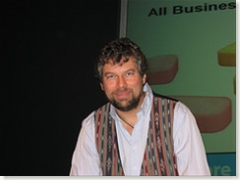John Battelle delivered the Friday afternoon keynote address on Blogs, Search and the Changing Media Landscape.
“Why am I standing in front of you? I went to Berkeley ;-)” The story: Wired. Hotwired. Industry Standard. The Standard. The 4th. quarter of 2000 – out of a job. Back to Berkeley. The Search. Searchblog. Web 2.0 Conference. Federated Media Publishing.
The Internaet Economy is the third wave of tech and culture.
- First wave: Digitize the Back Office. The C:_ command prompt. Only a few people touched the technology.
- Second Wave: Digitize the front office. The PC. A lot more people touched technology and a lot more money came into it.
- Third Wave: Digitize Customers. Google. Touches everyone.
Search is still in its infancy. We use the command prompt/search bar. But the big difference is that we can enter plain language. And that’s a big thing.
Web 2.0 principles:
- The web is a platform
- The architecture of participation: Companies understand that it is smart to let their customers help them make their business better. The web can be a platform to make that happen.
- Lightweight business models: Many companies were developing new things, but they weren’t trying to do it all by themselves. For example, up until recently, Google News had only 17 employees.
- The Long Tail: These companies were harvesting new value that was being created by the Web.
Search rules.
- Search drives Web 2.0 businesses.
- Our culture’s point of inquiry, the spade with which we turn the web’s soil, artifact of a new culture. Our search histories can be saved and mined and handed down.
- A new reality for all forms of tradition business. Paid search is the first true leveraging of the database of intentions.
When it comes to marketing, search has provided an entirely new catchment point for marketing. We declare our intent in the search box. Then search organizes the data and presents it to us. In the old media days, we would buy commercial space on programs/media drawing a demographic. Now, with search we can buy keywords – expressions of intent. Intent drives content.
Search drives content to social media sites … where consumers expect all participatns to understand the mores of those environments. And they expect businesses to know what they want.
Marketing becomes a dialogue, not a dictation of one to another.
Traditional media and marketing is ruled by distribution: if you get that, you get attention. Now, attention is not controlled by distributors, it’s controlled by the consumer. There are now new centers of attention: search and social media platforms.
Content is once again king, and the landing page is queen. All businesses must join the Point-to Economy (links = votes = attention).
The promise of the web is the ability to know who you customers are and what they want and then draw them into converation. This requires business to think differently about retrn on investment. Marketing is about more than satisfying demand. It’s also about creating it. And how do you measure that?
New advertising campaigns must recognize all of these factors and break out of the old mindset (no more dinosaurs, Microsoft!)
 Tod Maffin knows how to make Google sing. And he shares his tips for using Google on the Inside the CBC blog.
Tod Maffin knows how to make Google sing. And he shares his tips for using Google on the Inside the CBC blog.



 Munjal Shah, the CEO of
Munjal Shah, the CEO of